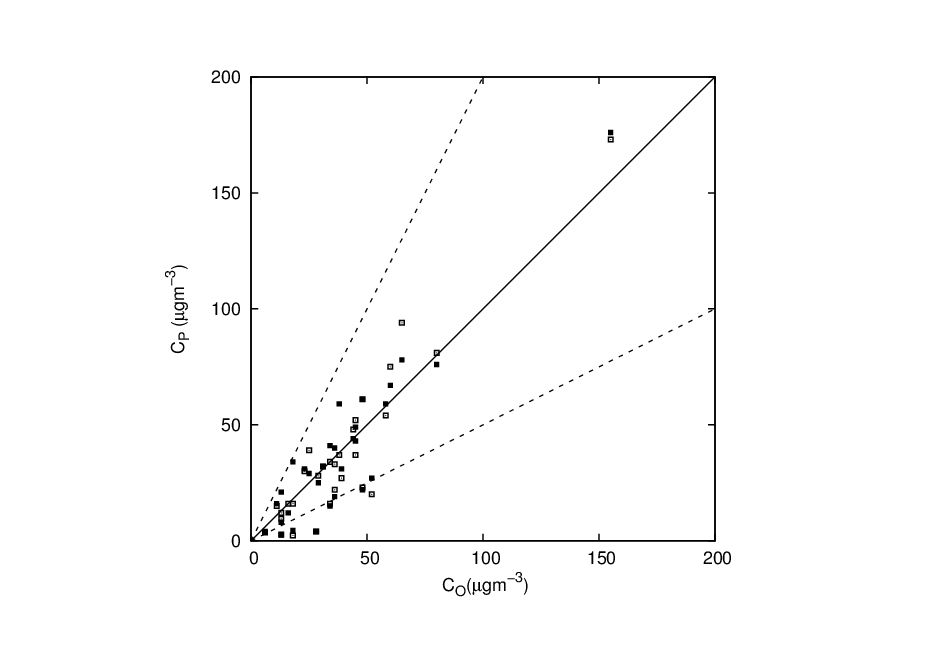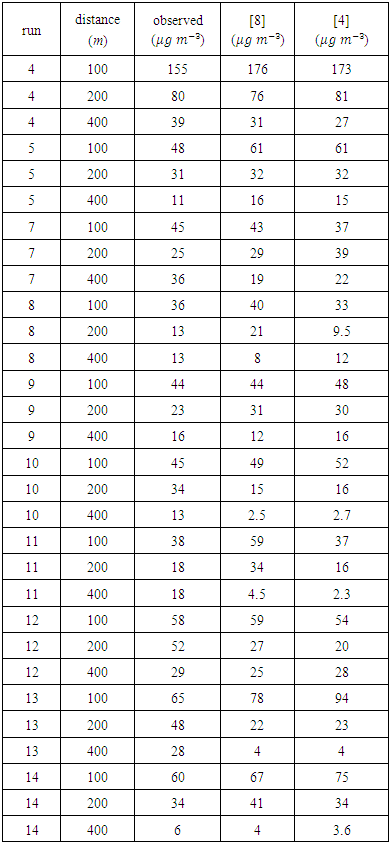-
Paper Information
- Next Paper
- Previous Paper
- Paper Submission
-
Journal Information
- About This Journal
- Editorial Board
- Current Issue
- Archive
- Author Guidelines
- Contact Us
American Journal of Environmental Engineering
p-ISSN: 2166-4633 e-ISSN: 2166-465X
2016; 6(4A): 46-49
doi:10.5923/s.ajee.201601.07

Meandering of Contaminant Dispersion
Lilian P. Moor1, 2, Lidiane Buligon3, Jonas da Costa Carvalho4, Gervásio Annes Degrazia1, Michel Stefanello1, Otávio Acevedo1, Luca Mortarini5
1Programa de Pós-Graduação em Física, Universidade Federal de Santa Maria, Santa Maria, RS, Brazil
2Instituto Federal Farroupilha, Jaguari, RS, Brazil
3Departamento de Matemática, Universidade Federal de Santa Maria, Santa Maria, RS, Brazil
4Faculdade de Meteorologia, Universidade Federal de Pelotas, Pelotas, RS, Brazil
5Institute of Atmospheric Sciences and Climate (ISAC) of the Italian National Research Council (CNR), Unit of Turin, Italy
Correspondence to: Lilian P. Moor, Programa de Pós-Graduação em Física, Universidade Federal de Santa Maria, Santa Maria, RS, Brazil.
| Email: |  |
Copyright © 2016 Scientific & Academic Publishing. All Rights Reserved.
This work is licensed under the Creative Commons Attribution International License (CC BY).
http://creativecommons.org/licenses/by/4.0/

In this study we present a simulation of the meandering of contaminant dispersion in a low wind stable boundary-layer. The horizontal wind meandering parameters are obtained from data were measured in Brazilian Amazon region. These new observational parameters are employed in the Iterative Langevin Solution for Low Wind (ILS-LW) model. The results are compared with the experimental data of Idaho National Engineering Laboratory (INEL). The simulated concentrations agree with the values presented and discussed in the literature.
Keywords: Contaminant Dispersion, Horizontal Wind Meandering, Lagrangian Dispersion Model
Cite this paper: Lilian P. Moor, Lidiane Buligon, Jonas da Costa Carvalho, Gervásio Annes Degrazia, Michel Stefanello, Otávio Acevedo, Luca Mortarini, Meandering of Contaminant Dispersion, American Journal of Environmental Engineering, Vol. 6 No. 4A, 2016, pp. 46-49. doi: 10.5923/s.ajee.201601.07.
Article Outline
1. Introduction
- The dispersion of contaminants in low wind speed conditions in the Stable Boundary Layer (SBL) represents a difficult physical problem as the occurrence of meandering winds do not allow traditional dispersion models to simulate adequately the contaminant concentration. Thus, it is essential to develop new parameterizations that describe such processes as they are observed in the atmosphere [1, 2]. In situations in which the wind mean velocity is small, the horizontal wind direction is subject to large variations. Therefore, it is not possible to determine a preferential direction [3, 4]. In these conditions, the large horizontal wind oscillations of low frequency, called meandering, spread the contaminants over a rather wide angular sector, which reinforces the horizontal transport of contaminant [1, 5]. Consequently, the meandering phenomenon needs to be incorporated in the simulations of the contaminant dispersion [6, 7]. In this particular case, the Lagrangian models are considered the more indicated, because they describe appropriately the dispersion process during the presence of the meandering. Furthermore, in these models it is possible to incorporate, in a more simple way, temporal and spatial variations in turbulence properties in relation to other techniques, such as similarity or gradient-transfer theory [8, 9]. In this study we employ the model ILS-LW [8] to simulate the enhanced meandering dispersion. The meandering loop parameter
 and meandering period
and meandering period  used in this simulation are obtained from observational data measured in Brazilian Amazon Region [4].The performance of the ILS-LW model using the meandering parameters proposed by Moor et al. [4] is validated considering the values of ground-level concentrations measured during the experiments of the Idaho National Engineering Laboratory (INEL) [10]. In addition, we present a statistical analysis to evaluate the simulation with new meandering parameters in comparison with the observed concentrations [10]. In Section 2 we present the Langevin model, in Section 3 the meandering parameters employed in the simulations and in Section 4 the results are discussed.
used in this simulation are obtained from observational data measured in Brazilian Amazon Region [4].The performance of the ILS-LW model using the meandering parameters proposed by Moor et al. [4] is validated considering the values of ground-level concentrations measured during the experiments of the Idaho National Engineering Laboratory (INEL) [10]. In addition, we present a statistical analysis to evaluate the simulation with new meandering parameters in comparison with the observed concentrations [10]. In Section 2 we present the Langevin model, in Section 3 the meandering parameters employed in the simulations and in Section 4 the results are discussed.2. Lagrangian Stochastic Particle Model
- Lagrangian stochastic particle models are based on Langevin equation [11], where the particle turbulent velocity is given by the combination between a deterministic term
 and a stochastic term
and a stochastic term  The velocity and the position of each particle, in each time, are obtained from the numerical integration of the equations:
The velocity and the position of each particle, in each time, are obtained from the numerical integration of the equations:  | (1) |
 is the turbulent velocity,
is the turbulent velocity,  is the displacement,
is the displacement,  is the mean wind velocity. The method applied solves the Langevin equation (Eq. (1)), in a semi-analytical manner, using the method of successive approximations, or Picard’s Iterative Method [8].
is the mean wind velocity. The method applied solves the Langevin equation (Eq. (1)), in a semi-analytical manner, using the method of successive approximations, or Picard’s Iterative Method [8]. 3. Experimental Physical Parameters of the Horizontal Wind Meandering
- [4] presented a new autocorrelation function to study horizontal wind meandering. From a dataset measured in Brazilian Amazon region, they obtained an experimental fitting that allows to calculate the meandering time scale and the loop parameter magnitudes for low wind speed in a nocturnal stable layer (Table 1).
|
 | (2) |
 | (3) |
 | (4) |
 | (5) |
 are hybrid quantities described in terms of the time scale for a fully developed turbulence
are hybrid quantities described in terms of the time scale for a fully developed turbulence  and a non-dimensional quantity that controls the meandering oscillation frequency
and a non-dimensional quantity that controls the meandering oscillation frequency  associated to large oscillation of the horizontal wind [1, 12, 13]. This autocorrelation function generates a negative lobe for the horizontal wind components attributed to the meander [1, 4].
associated to large oscillation of the horizontal wind [1, 12, 13]. This autocorrelation function generates a negative lobe for the horizontal wind components attributed to the meander [1, 4].4. Results and Discussions
- In the simulations the mean values of the loop parameter
 and the meandering period
and the meandering period  (Table 1) were employed in the ILS-LW model [8]. The results are compared with concentrations measured data in the Idaho National Engineering Laboratory (INEL) [10]. Furthermore, the concentrations data from our simulation are compared with the simulation performed by [8]. Table 2 shows the comparisons between the simulated concentration data and observed concentrations data.Figure 1 represents the scatter diagram between observed and predicted ground-level concentrations. The scatter over the central line shows that new parameterization to the meandering loop parameter and the meandering period inserted in this model reproduces satisfactorily the experimental data in low wind speed conditions. Furthermore, the concentrations simulated values are similar with those obtained by [8].
(Table 1) were employed in the ILS-LW model [8]. The results are compared with concentrations measured data in the Idaho National Engineering Laboratory (INEL) [10]. Furthermore, the concentrations data from our simulation are compared with the simulation performed by [8]. Table 2 shows the comparisons between the simulated concentration data and observed concentrations data.Figure 1 represents the scatter diagram between observed and predicted ground-level concentrations. The scatter over the central line shows that new parameterization to the meandering loop parameter and the meandering period inserted in this model reproduces satisfactorily the experimental data in low wind speed conditions. Furthermore, the concentrations simulated values are similar with those obtained by [8].
|
|
5. Conclusions
- In the low wind stable boundary layer, the contaminant dispersion is directly influenced by the meandering phenomenon, which is characterized by low frequency horizontal oscillations of horizontal wind. Therefore, the results of simulations accomplished during low wind speed periods depend of the meandering parameters inserted in the dispersion models. For the meandering dispersion we employ the meandering period and the loop parameter obtained from experimental data measured in Brazilian Amazon region in the ILS-LW model to simulate dispersion of contaminant. The concentrations obtained with the new observational meandering parameters were compared with the concentration measured data in the Idaho National Engineering Laboratory (INEL). The results presented and discussed are in agreement with experimental values found in the literature.
ACKNOWLEDGEMENTS
- The authors would like to thank the CNPq (Conselho Nacional de Desenvolvimento Científico e Tecnológico) and Capes (Coordenação de Aperfeiçoamento de Pessoal de Nível Superior) for partial financial support of this work.
 Abstract
Abstract Reference
Reference Full-Text PDF
Full-Text PDF Full-text HTML
Full-text HTML


